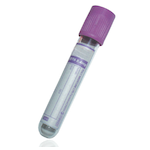Suitable Specimen Types
- EDTA Whole Blood
Specimen Transport
A normal EDTA sample collected on same day to act as a travel control is required if specimens are to be sent via post ; please ensure to attach full blood count of this travel control sampleSample Preparation
NoneTurnaround Time
72 hoursSample Stability
4°C for 7 daysGlucose-6-Phosphate Dehydrogenase Assay - G6PD
Notes
G6PD measurement is useful in the diagnosis of unexplained haemolysis, for patients receiving anti-malarial treatment and for patients who are at risk to tumour lysis syndrome when starting chemotherapy. This test is performed to quantify G6PD in patients.
As leucocytes and reticulocytes contain increased levels of G6PD a full blood count and reticulocyte count will also be performed on G6PD requests to allow appropriate interpretation of results. In cases of extreme anaemia, elevated leucocyte and platelet counts buffy coat free specimens will be used. Please consider the volume of blood supplied when requesting on neonatal/paediatric patients.
If the results are required urgently due to the start of chemotherapy please contact the laboratory 0121 424 0198.
Interfering Substances
- Copper completely inhibits G6PD at a concentration of 100 µmol/L, and sulfate ions (0.005 mol/L) decrease observed levels of G6PD activity.
- Certain drugs and other substances are known to influence circulating levels of G6PD.
- Reticulocytes have higher G6PD levels than mature red cells. It is recommended that assays not be performed after a severe hemolytic crisis, since G6PD levels may appear falsely elevated. Under those conditions, detection of deficiency may require family studies. Testing may be performed after the level of mature red cells has to returned to normal.
For referrals to us from other hospitals please ensure that you complete the referral form that can be found in the Downloads section and clearly indicate if a screen has already been performed.
Reference Range
8.8 - 12.8 IU/g Hb
Laboratory reference range established by in‐house testing
Specifications
- EQA Scheme?: Yes
- EQA Status: NEQAS
